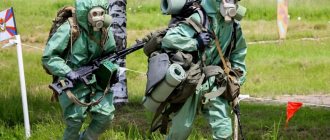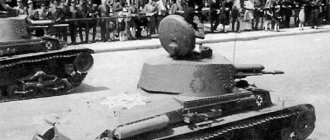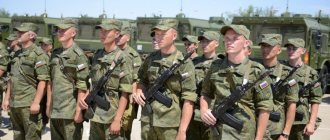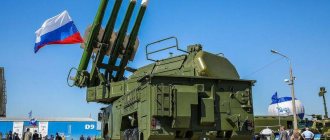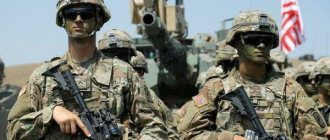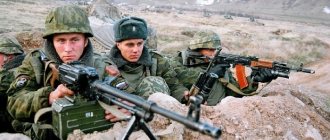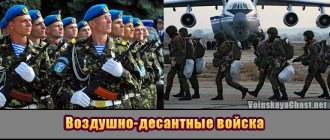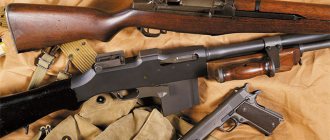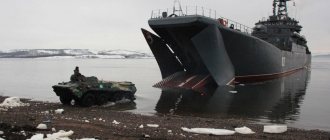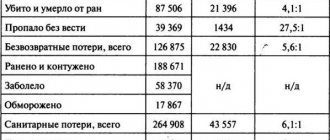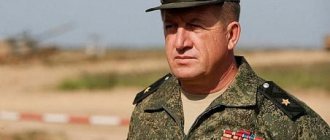It is safe to say that today the US Army is the strongest on the planet. The state, which does not have a potential enemy near its borders, was able to build powerful armed forces with the most modern weapons. America's military consists of just over a million military personnel (whose training is considered a modern model for most armies on the planet), as well as almost seven hundred thousand civilian employees. Up to five hundred thousand people serve in the ground forces, up to two hundred thousand in the reserve army, and almost four hundred and fifty thousand in the National Guard.
The American army occupies a leading position on the planet in terms of the level of funds spent on it. Thus, the 2016 military budget provided for spending more than $607 billion on the needs of the army, which amounted to more than 34% of global military spending. According to independent sources, this is three times more than China's defense spending and seven times more than Russia's.
General structure of the US Army
The US Army was founded in June 1775 by an act of Congress, it was intended to defend the young independent state. Modern American armed forces include independent types of armed forces:
- Ground troops;
- Air Force;
- Navy;
- Marine Corps (MCC);
- Coast Guard.
American military
Moreover, everyone except the Coast Guard is directly subordinate to the Minister of Defense, the latter is subordinate to the National Security Agency in peacetime, but during martial law it is also resubordinated to the Minister of Defense.
The US Constitution provides for the appointment of the President of the State by the Commander-in-Chief of the American Army. He, in turn, controls the national Armed Forces in peacetime, directing the civilian Minister of Defense, who reports to the heads of the sub-services of the Armed Forces. The heads of ministries deal with issues of recruiting, equipping, organizing and supplying the army, and also control the combat training of personnel. The highest military command of the branches of the Armed Forces are members of the Joint Chiefs of Staff. The chairman of this committee resolves issues of coordinating the activities of everything related to the military administration of the state.
The operational subordination of the US Armed Forces is currently reduced to nine unified commands, five of which are formed based on the geographical principle.
Five unified commands:
- North American;
- South and Central American;
- European;
- Middle Eastern and Asian;
- Pacific.
All branches of the US Armed Forces located in their areas of responsibility are subordinate to the commanders of these unified commands. The remaining four joint commands do not have their own areas of responsibility.
The Unified Commands include:
- Strategic Command. Deals with strategic planning issues, controls strategic nuclear weapons;
- Special Operations Training Command;
- Strategic Airlift Command;
- Unified Forces Command. Engaged in combat training in all branches of the Armed Forces.
US Airborne Forces (XVIII Airborne Corps)
| Emblem of the 18th Airborne Corps |
The US Airborne Forces have a rich tradition and an impressive military history. Airborne units are rightfully considered one of the most combat-ready in the American army. In addition, the US armed forces are one of the few that have massively and successfully used airborne troops for their intended purpose. However, unlike their Russian counterparts, the US Airborne Forces are not a separate branch of the military. If Russian paratroopers traditionally have the status of the elite of the armed forces, “special forces,” and are designated as a separate branch of the military, then the Americans consider their airborne forces only as a special component of the ground forces.
With really good training, the US Airborne Forces are, rather, not the elite of the armed forces, but a small army designed to be deployed in the shortest possible time to any region of the world. Organizationally, the US Airborne Forces are consolidated into the XVIII Airborne Corps, which, in addition to parachute and airborne units, includes tanks, motorized infantry, army aviation, support units, etc. At the same time, the 18th Airborne Corps has its own tasks and specifics of combat use, which differ from those of conventional corps.
In the combat composition of the US Army ground forces, the corps is the only operational unit of this type. It was formed in 1944 in the British Isles and took part in hostilities in Western European countries. After the end of the war with Germany, the corps was redeployed to the continental part and disbanded, but was re-established in 1951. Formations and units from its composition participated in combat operations in Korea, Vietnam, Grenada, Panama, the Persian Gulf zone, Haiti, Iraq and Afghanistan. The corps emblem is a dragon.
TASKS AND STRUCTURE OF THE XVIIITH AIR CORPS OF THE US ARMY
After the end of the Cold War, when the likelihood of a global armed conflict receded into the background, the Americans needed a military unit that could be transferred to a local combat zone anywhere in the world in the shortest possible time. The XVIII Airborne Corps is designed to solve such problems.
Currently, the organization, weapons and equipment of the US Airborne Forces have transformed from Cold War standards to modern requirements. As a rapid reaction force, the XVIIIth Airborne Corps has the highest operational tempo among the US Army corps. According to the requirements of the American command, an airborne or air assault battalion must be deployed to the theater within 18 hours after receiving an order, a brigade tactical group must be deployed after 96 hours, a light division must be deployed after 120 hours, and the entire corps must be deployed within 30 days. .
The corps will have five divisions: one airborne, two heavy, one air assault and one light division. The total number of personnel of the XVIII Airborne Corps is 88 thousand people.
Currently, the XVII Airborne Forces includes four divisions and various units and support units:
- 3rd Infantry Division (Fort Stewart);
- 10th Light Mountain Division (Fort Drum);
- 82nd Airborne Division (Fort Bragg);
- 101st Air Assault Division (Fort Campbell);
- 16th Military Police Brigade (Fort Bragg);
- 18th Artillery Brigade (Fort Bragg);
- 525th Military Intelligence Brigade;
- 20th Engineer Brigade (Fort Bragg);
- 1st Sustainment Group (Fort Bragg);
- 3rd Sustainment Group (Fort Knox);
- 20th RCBZ Group (Aberdeen);
- 1st Maneuver Reinforcement Brigade (Fort Polk);
- 35th Signal Brigade (Fort Gordon);
- 108th Air Defense Artillery Brigade (Fort Bragg);
- 18th Air Support Brigade (Pope Airfield).
The headquarters of the XVIIIth Airborne Forces is located at Fort Bragg. In addition to the support units that make up the corps, each division is assigned its own logistics support brigade (3rd, 10th, 82nd and 101st, respectively), directly subordinate to the command of the ground forces. In case of operations in a remote theater of operations, the corps can be reinforced with a fifth armored division.
Landing of paratroopers of the 82nd Airborne Division during an exercise in 2006. |
The 82nd Airborne Division ("All Americans") is one of the oldest units in the American Army. It was originally formed in 1917 as an infantry division. When it turned out that the unit included people from all 48 US states that existed at that time, the command nicknamed it “The All-American division,” which can most accurately be translated as “Division of All Americans.” In 1942, the 82nd became the first airborne division in the US Army. Currently, the 82nd Airborne Division is the only unit in the American Army designed for mass parachute landing. In the event of the outbreak of hostilities, its mission is to arrive in the designated area as soon as possible, carry out landings and take control of strategically important points in order to ensure the deployment of the remaining US Army forces. The main potential targets for the 82nd Airborne Division are airports and seaports. Immediately after landing, its personnel take control of the surrounding area and ensure the arrival of additional forces in the combat zone. The division is a strategic offensive formation and is always maintained at the highest level of combat readiness. Any of its soldiers, from a cook to a PC operator, from a shooter to an engineer, is a highly qualified military professional. Any unit of divisional weapons and equipment can be parachuted at any time.
The 82nd Airborne Division consists of:
- headquarters with headquarters company;
- reconnaissance and support companies;
- communications companies;
- orchestra;
- airborne school;
- 1st Brigade Combat Team (1st and 2nd Battalions, 504th Airborne Regiment, 3rd Squadron, 73rd Cavalry Regiment, 3rd Battalion, 319th Field Artillery Regiment, 307th Logistics Support Battalion , battalion of special troops: reconnaissance, communications);
- 2nd Brigade Combat Team (1st and 2nd Battalions, 325th Airborne Regiment, 1st Squadron, 73rd Cavalry Regiment, 2nd Battalion, 319th Field Artillery Regiment, 407th Logistics Support Battalion , battalion of special troops);
- 3rd Brigade Combat Team (1st and 2nd Battalions, 505th Airborne Regiment, 4th Squadron, 73rd Cavalry Regiment, 1st Battalion, 319th Field Artillery Regiment, 82nd Logistics Support Battalion , battalion of special troops);
- 4th Brigade Combat Team (1st and 2nd Battalions, 508th Airborne Regiment, 4th Squadron, 73rd Cavalry Regiment, 2nd Battalion, 321st Field Artillery Regiment, 782nd Logistics Support Battalion , battalion of special troops);
- army aviation brigade (headquarters, AH-64D Apache Longbow reconnaissance and strike battalion, UH-60M Black Hawk strike battalion, support battalion with control, transport and evacuation companies, OH-58D strike and reconnaissance squadron).
Soldiers of the 101st US Airborne Division in Afghanistan |
Currently, the 82nd Airborne Division, like the entire US Army, has been transferred to a modular structure. Units and subunits of the American army go into battle not in a permanent composition, but in the form of tactical groups, which can be assigned elements of different units as necessary. Due to the reorganization, a number of former division elements: artillery, logistics support, military police, etc. are now assigned to separate brigades. At the same time, an additional 4th brigade was introduced into the 82nd Airborne Division.
According to Western sources, in the process of serving, each of the division’s brigades goes through a cycle of three stages: maximum combat readiness, combat training and supply (repair of equipment, etc.). True, it is not clear how a long stay in “hot spots”, which does not belong to any of the stages, is linked to this cycle. It is possible that the emergence of the 4th brigade should ensure a cycle of four parts: maximum readiness - being in the combat zone - combat training - restoration of the material part.
The 101st Airborne Division (Screaming Eagles) is a light unit designed for airlift and landing by helicopter. These are not paratroopers, and the words “airborne” in the name of the division were retained only as a tribute to tradition. Often, when talking about the 101st Division, the more correct designation “air assault” is used.
Formed in 1918, the 101st Division is one of the most decorated units in the American Army. The division participated in almost every significant conflict where the US Army was involved: both world wars, Vietnam, the 1990-1991 Gulf War, Kosovo, Afghanistan, and the 2003 invasion of Iraq. In World War II and the beginning of the Vietnam War, the division participated as a parachute division, but since 1968 it was reformed - first into an airmobile division, and then into an air assault division.
Just like the 82nd Airborne Division, the 101st Airborne Division currently has a modular structure:
- headquarters with headquarters company;
- battalion of special troops;
- 1st Brigade Combat Team (1st and 2nd Battalions, 327th Infantry Regiment, 2nd Battalion, 320th Field Artillery Regiment, 1st Squadron, 32nd Cavalry Regiment, Special Troops Battalion, 426th Battalion rear support);
- 2nd Brigade Combat Team (1st and 2nd Battalions, 502nd Infantry Regiment, 1st Battalion, 320th Field Artillery Regiment, 1st Squadron, 75th Cavalry Regiment, Special Troops Battalion, 526th Battalion rear support);
- 3rd Brigade Combat Team (1st and 3rd Battalions, 187th Infantry Regiment, 3rd Battalion, 320th Field Artillery Regiment, 1st Squadron, 33rd Cavalry Regiment, Special Troops Battalion, 626th Battalion rear support);
- 4th Brigade Combat Team ((1st and 2nd Battalions, 506th Infantry Regiment, 4th Battalion, 320th Field Artillery Regiment, 1st Battalion, 32nd Cavalry Regiment, Special Troops Battalion, 426th logistics support battalion);
- 101st Army Aviation Brigade (1st, 5th, 6th Battalions, 101st Army Aviation Regiment, 2nd Squadron, 17th Cavalry Regiment with OH-58Ds, 96th Aviation Logistics Support Battalion).
Soldiers of the 1st Cavalry Regiment, 3rd Infantry Division during a training exercise |
The 3rd Infantry Division is a heavy formation within the XVIII Airborne Forces. It is armed with the full range of heavy weapons of mechanized formations of the US Army, including the M1A1 Abrams MBT. The heavy division cannot participate in the landing. Its task is to interact with the landing force during an offensive operation and move as quickly as possible to strategically important points occupied by airborne or air assault units.
Structure of the 3rd Infantry Division:
- headquarters with a battalion of special troops;
- 1st, 2nd and 3rd brigade tactical groups, similar in structure (special troops battalion, reconnaissance cavalry squadron with armored vehicles, armored battalion, mechanized battalion, self-propelled artillery battalion, logistics support battalion);
- 4th Brigade Combat Team (special forces battalion, vehicle reconnaissance cavalry squadron, two infantry battalions, towed field artillery battalion, and logistics support battalion);
- army aviation brigade (headquarters; reconnaissance and attack battalion with AH-1, AH-64 helicopters; supply battalion with CH-47 transport helicopters; reconnaissance cavalry squadron with OH-58 light helicopters; attack battalion with UH-60 multipurpose helicopters; aviation battalion rear support).
The 10th Mountain Division is a light rapid reaction unit whose units must be transported by air, sea or land to anywhere in the world within 96 hours of receiving a command. The number of personnel is about 10 thousand people.
Structure of the 10th Brigade:
- headquarters with headquarters company;
- battalion of special troops;
- 1st, 2nd, 3rd, 4th brigade tactical groups (two infantry battalions each, one reconnaissance cavalry squadron on vehicles, a towed field artillery battalion and a logistics support brigade);
- Army Aviation Brigade "Hawks" (headquarters, reconnaissance and strike battalion, strike battalion, supply battalion, reconnaissance cavalry battalion and aviation support battalion).
The 18th Field Artillery Brigade includes two In the future, it is planned to strengthen the brigade with a battery of UAVs.
The 525th reconnaissance (parachute) brigade includes
The 108th Air Defense Brigade consists of three battalions. The brigade is armed with the Patriot, Improved Hawk and other anti-aircraft missile systems.
The 20th Engineer Brigade consists of seven engineer battalions. Previously, all battalions of the brigade were considered parachute, and the personnel wore airborne insignia regardless of the qualifications of the paratrooper. Since 2009, the parachute status of the brigade has been abolished.
The 35th Signal Brigade includes four communications (parachute) battalions and support units. It is the only airborne signal brigade in the US Army. It is equipped with mobile communications equipment, including telephone equipment operating in analogue and digital modes.
The 16th Military Police Brigade consists of three battalions, each with four companies (three parachute and one air assault), and a logistics support unit.
The 18th Air Support Group has: a headquarters, 6 air support squadrons and one meteorological squadron. The main armament is helicopters of various types, including the AN-64 Apache anti-tank helicopters.
WEAPONS AND COMBAT EQUIPMENT OF THE US Airborne Forces
The paratroopers are armed with: M9 Beretta pistols, M16 rifles and M4 carbines, M14 rifles, M240 and M240B light machine guns, M249 Minimi platoon support machine guns, M2 Browning heavy machine guns, M203 under-barrel grenade launchers, Mk 19 automatic mounted grenade launchers , Tou ATGM, M2 Bradley BMP.
The main weak point of parachute units is considered to be an insufficient number of heavy weapons. As soon as the first wave of paratroopers manages to establish control of the runway, the landing force must be immediately reinforced with armored vehicles and heavy weapons. Until the mid-90s. The US Airborne Forces were armed with specialized light tanks M551 Sheridan with a 152-mm gun, which could be airlifted. However, they were later found to be ineffective; suffice it to say that the light aluminum armor of these tanks was penetrated even by heavy machine guns. With the removal of the Sheridan from service, a “hole” was formed in the range of weapons of the US Airborne Forces: American paratroopers were left without a vehicle that would give them additional firepower combined with security and mobility. As a potential replacement for the Sheridan, the US Army command is considering the Stryker Mobile Gun System (MGS) combat vehicle. This vehicle, in fact, belongs to the class of “wheeled tanks” that is considered promising at the moment. It is armed with a 105-mm stabilized gun with an effective range of 3000 m. This gun is best suited for fighting bunker-type targets (which is most important in anti-guerrilla operations), but can also fight tanks. In 2007, airborne brigades with MGS were deployed to Iraq.
The artillery of the US Airborne Forces is represented by towed 155-mm howitzers M777. This is a modern, very light weapon for its caliber (its mass is 3420 kg). The firing range of the M982 Excalibur ammunition with increased range and accuracy is 40 - 57 km, the circular probabilistic deflection of the projectile is from 5 to 20 m. In addition, the US Airborne Forces have a battalion of M142 HIMARS MLRS based on an army tactical truck. The installation contains 6 missiles, which can be fired one at a time, two at a time, or in one gulp. The firing range ranges from 2 to 300 km.
EQUIPMENT AND EQUIPMENT OF THE AMERICAN PAROARTER
As a rule, a US Army paratrooper is armed with a pistol and an M-16 automatic rifle. He has 700 rounds of ammunition and a night sight for his rifle. The rifle can also be supplied with a 40mm grenade launcher with twelve grenades. The paratrooper is equipped with three M25 anti-tank mines, a set of signal cartridges, six hand grenades, and a landing knife.
Chemical protective equipment - gas mask and special protective suit.
The individual first aid kit of an American paratrooper is equipped taking into account specific combat conditions: tropical, desert, arctic, island and universal options.
Each US Army paratrooper is provided with an HF radio, night observation goggles, lightweight body armor, and a plastic raincoat.
As for logistics support, compared to the airborne forces of other countries, it is much more powerful and less autonomous. The individual food set that the paratrooper carries with him is used only as a last resort as an emergency supply - under normal conditions, the nutrition of personnel is organized centrally.
Shoes and underwear have an internal autonomous thermoregulation system.
The set of toiletries, in addition to the usual soap, toothpaste and towels, includes such items as disinfectant wipes, insect repellent aerosol, special creams for hands, face, feet, and shampoo.
The cookware set is made of heat-resistant plastic, which, in turn, lightens its weight.
As for parachutes, their design and technical characteristics are similar to Russian ones. Although, according to experts, Russian parachutes are easier to operate and more reliable in mass use. But the American parachute is somewhat more compact and more convenient.
The equipment and preparation of the landing forces largely determine the combat capabilities of parachute units.
It must be recognized that high American-made technologies have a positive effect on the equipment and armament of the country's army. Convenience, durability of military field clothing, thoughtful household details, and constant improvement of ammunition are of an applied nature, which is verified by computers and during field experiments, combat training and exercises. Every little detail, every seemingly insignificant detail is taken into account. Entire mills and factories work for the US military-industrial complex; New research programs are being developed, weapons, equipment and protective equipment are being improved. New products are introduced into practice without delay, practically from the assembly line.
The downside of this comprehensive provision of troops is the soldiers’ habit of daily use of the achievements of scientific and technological progress, even in war. However, in the event of real global military operations that undermine the country's economy, this may negatively affect their combat effectiveness.
COMBAT TRAINING OF THE US Airborne Forces
Currently, the main emphasis in the combat training of American paratroopers is on actions in low-intensity armed conflicts, humanitarian and peacekeeping missions.
Combat training of the 18th Airborne Forces is carried out in “blocks”. First, individual training blocks are studied, and then a full-scale simulation of combat operations is carried out. American paratroopers are required to learn to interact with other parts of the US Army, Marine Corps, Navy and Air Force. To achieve this, the US Armed Forces are conducting large-scale exercises that involve tens of thousands of people, and the area of the “operational area” reaches a million square miles. Scenarios for responding to the “crisis in Central America” are also being worked out, that is, actions at the borders or directly on US territory.
A lot of attention in the training of the US Airborne Forces is paid to the speed of response to crisis situations. At any given time, amphibious formations must be ready to meet deployment speed standards. An important aspect of training is also joint maneuvers with troops of other NATO countries.
Individual combat and psychological training of American paratroopers is carried out under very harsh conditions. For example, the initial training course includes the adaptation of recruits to blood. The “battle” site is “decorated” with waste from the slaughterhouse - bloody entrails and parts of the carcasses of killed animals. In this fetid mess, American paratroopers crawl and even eat. It is believed that all this contributes to the development of composure. According to experts, such classes are particularly intense, psychologically challenging and involve maximum physical activity. In addition, they have a more individual focus, unlike ours, aimed at uniting units.
Comparing the combat capabilities of Russian and American paratroopers, we must be more capable of independent actions in small units. American paratroopers have more versatile equipment and fire support, which does not contribute to the development of the habit of relying only on themselves when fighting behind enemy lines. The US Airborne Forces are characterized by close interaction with fire and logistics support units, aviation, “heavy” units and formations. American paratroopers are primarily used as highly mobile line infantry. For raids and sabotage operations, the US Armed Forces have other units.
COMBAT USE OF US AIRBOARDS
The XVIIIth Airborne Forces is one of the most belligerent formations of the American army. The American army, in turn, is the most belligerent in the world. So the American paratroopers have plenty of combat experience. Let us consider only modern conflicts where the US Airborne Forces took part.
In 1990-1991, the XVIII Airborne Forces took part in the Gulf War. This war very well illustrates the concept of using American airborne forces. During Operation Desert Shield, paratroopers were among the first to arrive in the crisis area and covered the deployment of the main group of multinational forces in Saudi Arabia.
In 1991, during Operation Desert Storm, the XVIII Airborne Corps, along with other forces, participated in the “100-hour offensive.” The paratroopers operated on the left (western) flank of the multinational force grouping, while securing the western flank of the VII Corps. The XVIII Airborne Division at that time included the 82nd and 101st Airborne Divisions, the 24th Mechanized Division and the 3rd Cavalry Regiment. The French 6th Light Armored Division also operated under the operational control of the corps and in its area of responsibility.
82nd Airborne Division patrol in Mosul, Iraq. |
The offensive of the coalition forces, which ultimately led to the defeat and partial encirclement of the Iraqi group in Kuwait, was launched by an attack by the 18th Airborne Forces. By the middle of the first day of the offensive, February 24, 1991, American paratroopers captured key areas 180 km deep into enemy territory. Armored and rear units began to move towards them at a rapid pace. On February 25, the corps broke the resistance of two Iraqi divisions; The 3rd Brigade of the 101st Airborne Division landed behind enemy lines and captured the southern bank of the Euphrates. Corps losses were insignificant. On February 26, the 18th Airborne Forces made a rapid push to the northeast with the goal of slamming the “sack” of Iraqi units in Kuwait, and took control of the Euphrates Valley. On this day, the main role was played by the 24th “heavy” division, the “light” divisions covered the flanks. The XVIIIth Airborne Forces faced fierce resistance from an Iraqi Republican Guard division, two infantry divisions, and a commando brigade, but the Iraqi formations were ultimately defeated. On February 27, troops from the XVIII Airborne Forces landed north of Kuwait, almost at the border with Iran, thus “slamming” the trap with Iraqi units. The war was over. The airborne and mechanized units of the American army worked flawlessly.
In 1992, American paratroopers were involved in Operation Restore Hope in Somalia. They ensured the security of key facilities, airfields, and convoys with humanitarian supplies. True, after the extremely unsuccessful battle for the Americans in Mogadishu, US Army units left Somalia.
In 1994, the 82nd Airborne took part in Operation Restore Democracy in Haiti, where they helped restore power to ousted President J.B. Aristide. The latter was known as a schizophrenic and a murderer, however, he was considered an ally of the United States.
In the same year, American paratroopers were sent to the Panama Canal Zone (Operations Safe Sky and Safe Passage), where crowds of Cuban refugees attacked military personnel at an American Air Force base who were blocking their progress.
A soldier of the 10th Mountain Division in the mountains of Afghanistan. |
American airborne units took part in the aggression against Yugoslavia (1995 - Bosnia, 1999 - Kosovo).
When Operation Enduring Freedom was launched in Afghanistan in 2001, certain elements of the XVIII Airborne Forces were sent to help the NATO group. The 3rd Brigade of the 101st Airborne Division was one of the first to arrive in Afghanistan. In January 2003, during an anti-guerrilla operation, 70 soldiers of the 82nd Airborne Division parachuted into Western Afghanistan. The 10th Mountain Division also took an active part in combat operations in Afghanistan. Its units were in the first wave of the invasion forces in 2001-2002. and took part in the assault on Mazar-i-Sharif and the battles for Qala-i-Mzhangi and the Shaki-Khot gorge. In 2003, the headquarters and 1st brigade of the division returned to Afghanistan. They take part in several operations against the Taliban and Al-Qaeda. After the reform, the division's units were deployed again to Afghanistan in 2006-2007. In 2009, after a year's rest, the 10th Mountain Division, which had previously fought in Afghanistan, was transferred to Iraq.
In March 2003, with the start of Operation Iraqi Freedom, American paratroopers from the 82nd Airborne Division were assigned to the 75th Ranger Regiment to parachutely capture Baghdad International Airport. However, the operation was cancelled. The paratroopers also guarded multiple launch rocket systems on the march, which were supposed to suppress enemy artillery in the western part of Iraq. At the same time, the 101st Airborne Division was clearing Iraqi fortified positions during the offensive, paving the way for the 3rd Infantry Division. The airport, which was initially planned to be taken by paratroopers, was eventually occupied by units of the 101st Airborne Division and the 3rd Infantry Division.
Soldiers of the 10th Mountain Division in Kunar Province, Afghanistan. |
After the defeat of Saddam's army, units of the corps continued to serve in Iraq on a rotational basis: they fought partisans, ensured elections, etc. In 2004, units of the 82nd Airborne Division were temporarily deployed to Afghanistan to provide security for elections in that country.
In 2006, the corps underwent reorganization: a modular management structure was introduced, a number of units, including the corps headquarters, were deprived of parachute status. Landing functions were left at the level of brigade tactical groups.
In January 2007, units of the XVIII Airborne Forces: headquarters, 4th brigade tactical group of the 82nd Airborne Division and the 18th Army Aviation Brigade were transferred to Afghanistan. At the same time, the 3rd Brigade Combat Team of the 82nd Airborne Division and the 10th Mountain Division were extended their stay in Afghanistan to ensure they had enough troops to counter the expected Taliban offensive in the spring. The 1st and 2nd battalions of the 508th Parachute Regiment operated in the province of Ghazni, where they were engaged in equipping and maintaining strongholds and patrolling. In March 2008, the 4th Brigade returned to Fort Bragg after a 15-month deployment to Afghanistan. In 2009, the 4th Brigade was returned to Afghanistan. In April 2012, the 1st Brigade was deployed to Afghanistan, and together with the Polish contingent carried out anti-partisan operations in the province of Ghazni.
All brigades of the 101st Airborne Division also passed through Afghanistan: in 2007-2009 and 2010. Each unit spent 12 months in Afghanistan. Moreover, in 2010, all four brigade tactical groups of the division were simultaneously deployed in Afghanistan. From its second deployment through June 5, 2011, the division suffered 131 personnel killed, its highest death rate since Vietnam.
In addition to combat operations, mention should be made of the participation of American paratroopers in humanitarian missions: assistance to victims of Hurricane Katrina in 2005 and the earthquake in Haiti in 2010.
(Prepared by: https://www.modernarmy.ru)
Recruiting the American Army
The American army is recruited voluntarily and is based on a contract basis. American citizens or permanent residents of the United States of America who have a residence permit and have at least a secondary education are accepted for service. The minimum candidate age for military service is 18 years. However, if you achieve parental approval, you can go to serve at the age of seventeen.
US Army soldiers on the march
The age limit for active military service is determined for each branch of the US Army. So, for example, the age limit could be:
- Air Force and Coast Guard - 27 years;
- Marine Corps - 28 years;
- Navy - 34 years;
- Ground forces - 42 years.
Each contract soldier signs a service contract for a period of four to eight years.
National and racial composition
The United States of America is a multinational state. The national composition of the country is represented, in addition to Europeans, by African Americans, Asians and Latin Americans. The same picture is reflected in the formation of the American army.
Thus, according to information from open sources, the following serve in the American Armed Forces:
- European Americans - 63%;
- African Americans - 15%;
- Hispanics - 10%;
- Asians - 4%;
- Indians and Alaska Natives – 2%;
- Others from different mixed marriages - 2%;
- 4% were undecided on their race or nationality.
It should be noted that the latter group includes those who do not have American citizenship, but have the right to permanent residence in the United States. Most of them join the military because it makes it much easier to obtain American citizenship.
Conditions of service
Food and accommodation
Immediately after admission, a young soldier receives 3 meals a day in the canteen; as soon as he is transferred to an armed forces base, his allowance is paid from $100 to $300 a month. They can be spent in a store or cafeteria. Soldiers who are not married live in barracks of 2 people. If a soldier is married, he is provided with a separate house, or the state compensates for renting an apartment - the choice is up to the soldier.
Salaries in the army
The United States of America is truly interested in ensuring that its military personnel are paid well for giving back to the country. As soon as the recruit enlists, a significant amount of money is deposited into his bank account - from 10,000 to 30,000 dollars! In addition, monthly allowance starts at $1,300 and then only increases (for example, after three months of service, earnings increase by $200-300).
The maximum compensation for enlisted personnel is $4,000. Officers earn twice as much. True, becoming an officer is not so easy: you need to have US citizenship, a bachelor's degree (or you can try to go straight to a military academy), and successfully pass tests.
As for the senior command staff, generals have an income of 150,000-200,000 dollars a year.
Security of the US Army in comparison with other countries.
Gender
American military personnel are divided by gender:
- Men – 86%;
- Women - 14%.
For many years, it was generally accepted that only officers could be professional soldiers in the American army. However, after the Vietnam War, during the period of army reform in the early seventies, non-commissioned officers and warrant officers received the status of professional military personnel.
Mobilization resources
The total American population is more than 325 million people. This provides the army with extremely large mobilization resources. According to some estimates, mobresources may amount to more than one hundred and ten million American citizens.
Every year, more than four million Americans and American women reach military age. In addition, the state has at its disposal approximately eight hundred and fifty thousand so-called “reservists” of all branches of the military. A separate branch of the military is the American National Guard, formed by reserve groups created by the Army and Air Force. The total number of National Guardsmen in the United States is approximately three hundred fifty thousand military personnel.
Features of service in the US National Guard
A special feature of service in the American National Guard is the combination of service and work in a civilian specialty. Every year, the National Guard accepts approximately sixty thousand American citizens into its ranks. All of them are required to undergo combat training in groups and individually. There are forty-eight programs of four hours each, running on weekends throughout the year.
In addition, National Guardsmen are sent to camp for two weeks to participate in command post and military exercises together with Army units. All employers are officially warned that if they try to prevent National Guard soldiers from carrying out the service and combat tasks assigned by the state, they may even face criminal liability.
In addition to patriotic feelings, Americans are motivated by various benefits provided to those serving in the US National Guard:
- Increase to pay for accommodation;
- Increase to pay for treatment;
- Preferential sale of goods and products in military stores;
- Refueling at military gas stations (at a price 50% cheaper than the market price);
- Increase in pension;
- Other.
US National Guard recruitment system
Now the US National Guard is solving the same problems as before. During mobilization, guardsmen join the regular army.
Divisions
The composition is represented by the following divisions:
- 17 headquarters;
- 8 divisions;
- 40 engineer battalions;
- 32 aviation battalions;
- 13 regional commands;
- 42 artillery battalions;
- 15 brigades;
- 11 missile divisions;
- 12 training divisions.
Local leadership is carried out by adjutant generals. Their area of responsibility includes receiving recruits, training them and assigning ranks.
Tasks
The task for implementation is set by immediate local management. The head of the bureau is responsible for interactions with the authorities, construction, financial issues and equipping the National Guard with everything necessary.
Mobilization of the reserve requires an order from Congress or the President. Soldiers are regularly deployed to fight both inside and outside America.
National Guard
Features of US military doctrine
Recently, the American military leadership has proposed concentrating its resources in five important areas:
- Elimination of terrorism and expansion of weapons of mass destruction;
- Intelligence service;
- Preparation for information wars, including the protection of one’s information and communications systems, as well as the elimination of similar enemy systems;
- The struggle for military superiority in the airspace with an emphasis on the development of unmanned aircraft;
- Development of military space technologies.
At the same time, American military doctrine pays attention to preparations for military clashes during unconventional and hybrid conflicts.
Armament of the US Army, Air Force and Navy
Infantry weapons:
- Tanks - over eight thousand;
- Armored combat vehicles - almost twenty-six thousand;
- Self-propelled artillery guns - almost two thousand;
- Towed artillery - almost one thousand eight hundred;
- Missile systems - more than one thousand three hundred.
Air Force:
- Aircraft - more than thirteen and a half thousand;
- Fighters - more than two thousand two hundred and twenty;
- Fixed-wing combat aircraft - more than two thousand six hundred;
- Military transport aircraft - more than five thousand two hundred;
- Training aircraft - more than two and a half thousand;
- Helicopters - more than six thousand;
- Combat helicopters - more than nine hundred.
Navy:
- Total combat units - up to five hundred;
- Aircraft carriers - ten;
- Frigates - fifteen;
- Destroyers - more than sixty;
- Submarines - more than seventy;
- Coastal defense ships - thirteen;
- There are thirteen mine cruisers.
Military units and formations
- A squad consists of nine to ten military personnel, these are US Army soldiers commanded by a sergeant. The smallest structural element in the US Army;
- Platoon (platoon) - sixteen to forty-four military personnel led by a lieutenant. A platoon consists of two to four squads;
- Company (company) – sixty-two to one hundred and ninety military personnel. It consists of three to five platoons, the company is commanded by a captain;
- US Army battalion - three hundred to thousand military personnel. Consisting of four to six companies, the battalion is commanded by a lieutenant colonel;
- Brigade – three to five thousand military personnel. It consists of three to five battalions led by a colonel;
- Division - ten to fifteen thousand military personnel. Its usual composition is three brigades, the division is headed by a major general;
- Corps - two to forty-five thousand military personnel. It consists of two to five divisions, the corps is controlled by a lieutenant general;
- Army – fifty thousand military personnel. Typically, an army is commanded by a lieutenant general or a general of higher rank. It usually consists of two or more corps (one of them can be a tank).
Infantry uniform
American troops began switching to khaki (mustard brown) uniforms in 1903, following the war with Spain for control of Cuba. The uniform that was issued to the infantry was introduced around 1912.
The infantrymen wore khaki cloth uniforms (model 1912), which were fastened with five bronze buttons with an eagle emblem. The shade of the uniform could vary depending on the age of the material, the place of its manufacture and the conditions of wearing. At first, the uniform had four pockets (the modified 1918 version had secret pockets), shoulder straps and a stand-up collar. At the ends of the collar there were bronze discs (this idea was born in 1902). True, sometimes the discs were made of dyed leather rather than metal.
On the right circle there was an abbreviation: US for soldiers of regular units, USNG for national guardsmen and USNA for soldiers from conscript units. These insignia were gradually phased out in 1918, but until then some regiments managed to make their own versions of them (usually with regimental numbers). On the left disk was the emblem of the owner's branch of the military. For the infantry, these were crossed rifles (sometimes with the regiment number or company letter designation under the emblem, sometimes with letter designations, for example, MG (from machine gunner - machine gunner) above the emblem). An army shirt was worn under the uniform. A common accessory was a neckerchief.
Major General, 1918. Brodie's British raincoats and helmets were popular with senior American Army officers.
General Pershing (left) was appointed commander of the American Expeditionary Forces that arrived in France in 1917.
Breeches were made from the same material. They had two side and back pockets and were fastened with buttons under the knee, which was not very convenient for marching soldiers. For the winter, soldiers received double-breasted overcoats with two rows of buttons of the same type as on the uniform. The overcoats were very long, and the soldiers soon realized that they became heavy if they became wet or covered with a layer of mud. In 1918, production of shorter overcoats began. Sometimes soldiers were given waterproof canvas raincoats. The officers provided for themselves or bought raincoats locally. Capes with hoods were also common. In the summer, soldiers could wear a cotton uniform, similar in cut to cloth.
Upon arrival in France, the Americans surprised the Allies with their pointed-crowned hats called "Montanas." The hats did not protect their owners from bad weather or from bullets and shrapnel, so they soon began to be used only in the rear. Ordinary infantrymen wore Montanas with a blue cord, while officers wore them with black and gold. Some units that arrived in France received Hadrian's helmets. They were also received by divisions consisting of black Americans who fought as part of the French army. British-made helmets were also used.
Private, 9th Infantry, 1917. The first soldiers to arrive in France in 1917 were wearing the 1912 pattern uniform. Note the peaked hat (aka "Montana" aka "lemon squeezer" - lemon juicer)
Captain, 167th Infantry, spring 1918. Although many American officers wore riding boots, boots and wraps were common at the front.
Almost 400,000 British helmets were initially purchased. In addition, the production of the American version (1917 model) was hastily organized. American helmets were produced painted greenish-sand. They were almost identical to the British version, the only differences being the balaclava and serial number. Caps were very popular and were worn both in the trenches and in the rear. Officer caps often had blue piping, while general caps often had gold piping. Boots at the front quickly wore out, and in 1917 a new type of footwear was introduced. These were the so-called Pershing boots, brown in color, lined with wide-headed nails. Typically, Pershing boots were worn with tapes, although canvas gaiters were still available in 1918.
Patches and insignia
Chevrons and stripes of the US Army are distinctive signs that are attached to clothing and reflect affiliation with certain structures, official position, type of troops, as well as service in a particular unit. In addition, chevrons with stripes may indicate length of service, terms of study at a military educational institution, military or special ranks in the US Army. They can complement shoulder straps and buttonholes or even replace them. It may also be a rating badge, or "US Army badge."
Modern US Army
Most of the US Army's modern weapons can be seen in the Army. This branch of the military is the largest in the US Army. Its main purpose is to conduct large-scale military ground operations. In total, the ground forces of the United States of America number more than 540 thousand military personnel. Currently, the Ground Forces are undergoing a reform process, which, unlike Russian military reforms, has lasted for years, since the Americans approach this process very responsibly and carefully.
The tank composition of the US Army consists of 5.5 thousand Abrams tanks, the preparation of which is carried out by specially trained teams of mechanics. Unlike many European armies, most of whose tanks are not operational, the US Army's tanks are in combat-ready condition. 1174 Abrams tanks are modernized modifications that have more powerful weapons.
If we take the total number of American armored vehicles in service in the US Army Ground Forces, then there are more than 37 thousand of them. Just like tanks, armored vehicles are in excellent condition and are serviced promptly.
Artillery weapons of the ground forces are represented by the following types:
- Mortars of various calibers;
- Artillery towed guns with 105-155 mm guns in a total quantity of 1,100 pieces;
- There is self-propelled artillery, represented by the M109 “Paladin” self-propelled gun. In addition, there are M142 missile systems that have a wheeled chassis.
750 AH-64 Apache attack helicopters are also part of the US Army. They carry powerful weapons on board and are designed for fire support and various combat operations. In addition to the Apaches, there are about 400 Chinook transport helicopters and 600 Kiov multi-purpose light helicopters. There are 120 MH-60 Black Hawk helicopters. The training of combat helicopters in the US Army is also at a high level.
The air defense of the Ground Forces is represented by 1,300 units of various complexes, the most common of which is the FIM-92A Avenger, which is represented in more than 700 units. The FIM-92 Stinger MANPADS are used as weapons used for low-flying targets.
